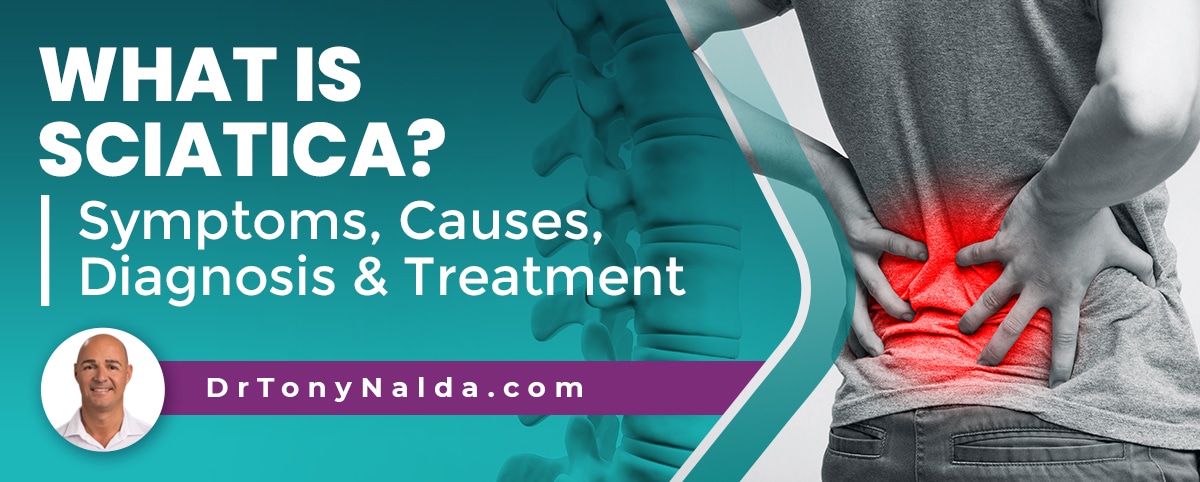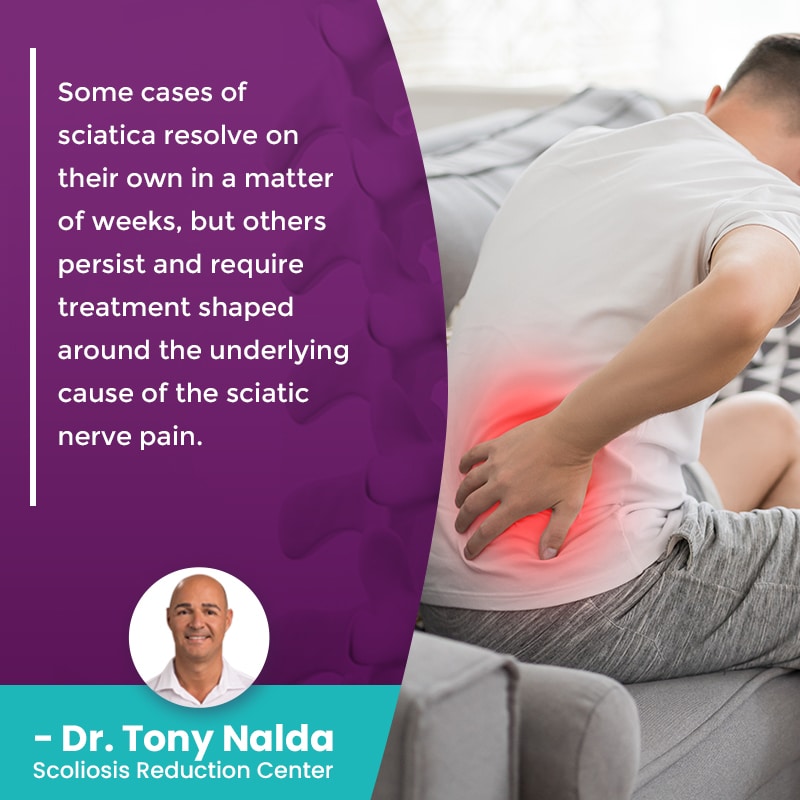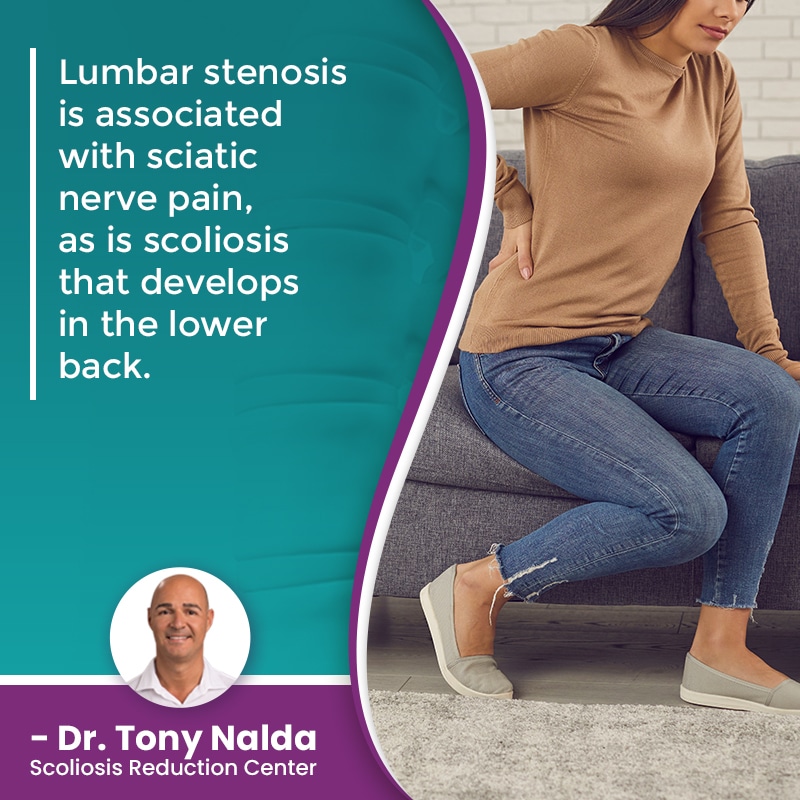What Is Sciatica? Symptoms, Causes, Diagnosis & Treatment

The sciatic nerve is the largest in the body, starting in the lower back and extending down the back of the hip, buttock, leg, and into the foot. Sciatic nerve pain has a number of causes, including spinal degeneration and/or the presence of an underlying spinal condition.
While many consider sciatica to be a clinical condition, the term sciatica actually refers to a set of symptoms that involve sciatic nerve irritation and pain, but doesn't specify the nature of that pain, nor the cause of it; the main cause of sciatic nerve pain is spinal degeneration.
To better understand the nature of sciatic nerve pain, let's first explore some basic spinal anatomy.
Table of Contents
Anatomy of the Spine
The spine consists of vertebrae (bones of the spine) stacked on top of one another, and when the vertebrae are aligned as they are in a healthy spine, its natural and healthy curves are in place.
Adjacent vertebral bodies are separated by an intervertebral disc, and these discs are key to the spine's strength, flexibility, and function.
The discs consist of two parts: a tough and durable outer annulus that encloses a soft gel-like inner nucleus.
When the spine starts to degenerate, it's most often the discs that are the first structures to start to deteriorate, and as the spine contains 31 pairs of spinal nerves, spinal degeneration affects the nerves within, and at their roots where they exit the spinal cord and branch off to different areas of the body.
Now, when the spine is degenerating in some way, it also affects the spine's surrounding muscles and nerves, and there are three main sections to the spine: the cervical spine (neck), the thoracic spine (middle/upper back), and the lumbar spine (lower back).
In most cases of spinal conditions/issues, it's the area of the body located the closest to the affected spinal section that's going to feel the majority of its direct effects.
What is Sciatica?
Sciatica is not the name of a clinical condition; it is a term referencing the sciatic nerve being compressed, pinched, and/or impinged, and symptoms of sciatic nerve pain felt along the pathway of the sciatic nerve, as a result.
The sciatic nerve is the largest and starts in the lumbar spine where it branches off throughout the lower body; symptoms are largely felt in the lower body.
If the sciatic nerve is exposed to uneven pressure, as a mixed nerve containing both motor and sensory fibers, sciatic nerve dysfunction can affect both sensation and mobility.
In most cases, sciatic nerve pain is felt down the left side of the body, but it can also be felt in the right, and rarely affects both.
Depending on severity, pain can involve mild intermittent flare ups, or be chronic and debilitating.
 Some cases of sciatica resolve on their own in a matter of weeks, but others persist and require treatment shaped around the underlying cause of the sciatic nerve pain.
Some cases of sciatica resolve on their own in a matter of weeks, but others persist and require treatment shaped around the underlying cause of the sciatic nerve pain.
Pressure on the sciatic nerve can cause a number of symptoms and have a number of causes.
Sciatica Symptoms
Symptoms vary from patient to patient based on severity and causation, but common symptoms of the sciatic nerve being pinched include severe pain, pain down the affected leg, back or spine pain, muscle weakness, leg pain, night severe pain, pain after prolonged sitting, sharp pain, stabbing pain, knee weakness, shooting pain, lower leg pain, lower leg weakness, and other sciatica symptoms can include strange sensations like tingling and numbness.
How long does sciatica pain last? The answer will be case-specific, but most cases involve flare ups during which time symptoms intensify, then abate.
If the source of sciatic nerve pain is left unaddressed, more serious complications can occur including permanent nerve damage and nerve pain.
While nerve-related disorders aren't always easy to diagnose as nerve pain is often felt far from the location of the affected nerve, sciatic nerve pain, being most commonly felt down the left side of the lower body, is easier to diagnose.
Sciatica pain can have a number of causes from spinal degeneration to the presence of an underlying spinal condition.
Sciatica Causes
The most common cause of sciatic nerve pain is the nerve being pinched due to changes in the spine; these changes are caused by natural age-related spinal degeneration and the cumulative effect of certain lifestyle factors.
There is a certain degree of spinal degeneration to be expected with age, and how a person has lived their life will factor into the level and rate of age-related spinal degeneration.
Important lifestyle factors include carrying excess weight, low activity levels, chronic poor posture, excessive consumption of alcohol and/or smoking, and repeatedly lifting heavy objects incorrectly.
When the spine degenerates, it's usually the discs that are first spinal structures to feel the effects, and when a disc deteriorates, it changes shape and takes up more space within the spine than it used to, and that space comes from somewhere; in many cases, it's space inside the spinal canal that's used by the spinal nerves to function within.
Degenerative disc disease is a contributing factor in the development of a number of spinal conditions, sciatic nerve pain included.
When a disc degenerates, it often involves desiccation, and the disc changes shape as s result, generally losing height; if the affected disc is located in the lumbar spine where the sciatic nerve originates, this can introduce uneven pressure on the sciatic nerve, and this type of compression can result in the nerve being impinged and irritated.
The presence of underlying spinal conditions like scoliosis and spinal stenosis can also contribute to the occurrence of sciatic nerve pain.
Stenosis involves a narrowing of the space within the spinal canal, and the spinal cord, consisting of the 31 pairs of spinal nerves, passes through the spinal canal, so if the spinal canal loses some space within, the nerves are compressed and can't function optimally.
 Lumbar stenosis is associated with sciatic nerve pain, as is scoliosis that develops in the lower back.
Lumbar stenosis is associated with sciatic nerve pain, as is scoliosis that develops in the lower back.
Scoliosis involves the development of an unnatural sideways-bending and rotating spinal curve, and when it develops in the lumbar spine, where the sciatic nerve begins, the unnatural spinal curve can mean uneven pressure on the sciatic nerve, and pain is often felt as a result.
Scoliosis, as a progressive condition, has it in its nature to get worse over time, so if lumbar scoliosis is left untreated, it can lead to lumbar radiculopathy and ongoing sciatica pain.
Sciatica Treatment
Once a nerve is damaged, it's difficult, if not impossible, to reverse the damage, so the goal is early diagnosis and treatment before radiculopathy becomes a permanent issue.
The first step to treating sciatica pain is determining its underlying cause and shaping a treatment plan around it.
If spinal degeneration is the cause, lifestyle guidance can help, and a combination of condition-specific chiropractic care and physical therapy can help preserve disc health and function, and increasing circulation around an affected disc can make nutrients needed for repair more readily available to the disc; spinal discs don't have their own vascular supply, and absorb what they need from their surroundings in a process similar to osmosis.
If spinal conditions such as stenosis and/or scoliosis are the cause, they have to be the focus of treatment, and chiropractic care can help create space within the spine and take pressure off the sciatic nerve, relieving symptoms like sciatica pain, and can also help address areas of vertebral subluxation.
Physical therapy and scoliosis exercises can also help with increasing core strength so the spine is optimally supported by its surrounding muscles, taking pressure off its individual structures.
Corrective bracing can help address spinal conditions involving unnatural spinal curves by pushing the spine into a straighter position, and rehabilitation is also an important part of addressing underlying spinal conditions causing a pinched sciatic nerve.
Here at the Scoliosis Reduction Center, the best way to minimize the effects of spinal conditions is to address them proactively, particularly progressive conditions that are virtually guaranteed to get worse over time.
Conclusion
When sciatica occurs because of spinal degeneration, this can be age and/or lifestyle related, and treatment often involves specific chiropractic care, physical therapy, and lifestyle guidance.
There are varying degrees of sciatic nerve pain, but it's said that nerve-related back pain is among the most debilitating forms, and as the lumbar spine has to support the weight of the spinal sections above, the entire trunk, and its vertebrae feel the effects of bending, lifting, and twisting motions, it's vulnerable to a number of spinal condition/issues.
As the sciatic nerve starts in the lumbar spine, extending down the back of the hip, buttock, leg, and into the foot, its pathway is extensive, and symptoms of sciatic nerve compression can be felt anywhere along its extensive pathway.
Symptoms of sciatic nerve dysfunction can include sharp shooting pain throughout the lower body, lower back pain, muscle weakness, and tingling and/or feelings of numbness.
While some people's sciatic nerve pain resolves in a few weeks, others require treatment, particularly those caused by the presence of an underlying spinal condition or issue.
Here at the Center, the best way to minimize the effects of spinal conditions such as stenosis and/or scoliosis is to treat them proactively and effectively with a conservative treatment approach.
Dr. Tony Nalda
DOCTOR OF CHIROPRACTIC
After receiving an undergraduate degree in psychology and his Doctorate of Chiropractic from Life University, Dr. Nalda settled in Celebration, Florida and proceeded to build one of Central Florida’s most successful chiropractic clinics.
His experience with patients suffering from scoliosis, and the confusion and frustration they faced, led him to seek a specialty in scoliosis care. In 2006 he completed his Intensive Care Certification from CLEAR Institute, a leading scoliosis educational and certification center.
About Dr. Tony Nalda
 Ready to explore scoliosis treatment? Contact Us Now
Ready to explore scoliosis treatment? Contact Us Now





